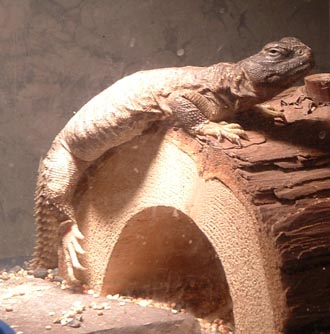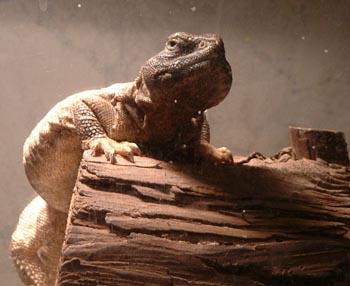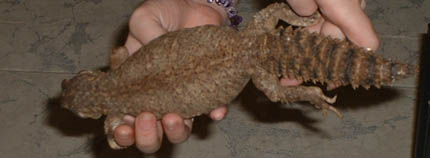

Molly is a 2 year old Mali Uromastyx. She came to us in December of 2003 from an owner who, put simply, had grown quite bored of her. When we brought her home her 10 gallon tank (for a 12 inch lizzard) reeked so bad of cigarette smoke that you could smell it down the hallway. The above picture is of when we first brought her home. We'll be adding more photo's as she get's more comfortable with us.

Uromastyx require a very varied diet, which due to inadequate
information available, Molly was not getting. She was being fed lettuce
and bird seed, which was not meeting her complex nutritional needs. She
is now on a diet consisting of colalrd greens, mustard greens, turnip
greens, prickly pear cactus pads, and other fruits and vegetables. She
is now also getting the high basking temperatures that she needs and
was not getting (previously she was getting basking temperatures around
90 degrees, they need 115-130). It's unfortunate what people do when
they are ill informed. She's allready getting more color than you can
see in the pictures here, more pictures will be posted soon - including
her current enclosure (30 tall tank... can't wait till I can build her
custom one!)

One of the best sites that I have found on the Mali is at http://jason.creager.com/uros.html
the text below is from that site.
Uromastyx maliensis are a species of spiny tailed desert
lizards which occur primarily in the landlocked African country of The Republic of Mali.
Formerly, they were referred to as "spiny tailed lizards", "Dabb's
lizard", or "mastigures", but "uromastyx" is currently the term most
commonly used in the herp trade. Uromastyx are diurnal (daytime active)
lizards which live in arid conditions. They are primarily herbivores,
but are opportunisticly carnivorous when an unlucky insect wanders
within eyesight. The areas they inhabit are sparsely vegetated, so life
is difficult at best and any available food source is utilized. They
are long lived and slow growing lizards due to the scarcity of food and
harsh environment.
Uromastyx have many interesting features. While only distantly related to the chuckwallas of the desert southwest United States, they are a fascinating example of convergent evolution since the two separate species have evolved to fill similar niches in their environments. Head size and shape and their methods of defense are strikingly similar.
One of the main problems with the husbandry of these marvelous species is that because they are so new to the herp world very little is known about them. We look forward to providing Molly with the best care possible!